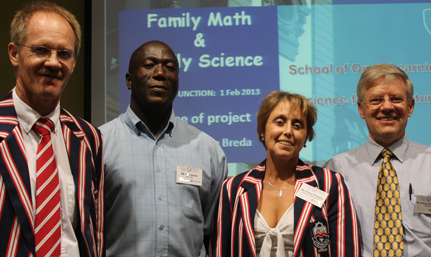|

|
At the launch were Dr Cobus van Breda, Director of the Science-for-the- Future Unit at the UFS, Mr Makhetha Botsane from the Free State Department of Education Mrs. Elizna Prinsloo, Programme Manager of the Family Maths and Family Science project and Mr Graham McCulloch, Free State representative of the Ilima Trust.
Photo: Kelly Abrahams
05 February 2013 |
The University of the Free State’s UFS) Family Maths and Family Science project has received a R1 million sponsorship from Old Mutual for 2013. This is a three-year project whereby the university’s School of Open Learning aims to demystify mathematics and science in the early school years, as stated in their mission. The launching ceremony took place on 1 February 2013 at the UFS Campus.
The sponsorship was made available by Old Mutual, but will be managed by the project management group, Ilima Trust.
The UFS received R30 million altogether from Old Mutual for the use on various projects.
Except for the Family Maths and Family Science project, the Schools make over project and the Internet Broadcasting Programme will also benefit from this donation.
“Ilima has a hands-on relationship with different projects and is the public face for the FM & FS sponsorship,” said Mr Graham McCulloch, Ilima Trust representative for the Free State.
“Today is the first step on the long road to improving math and science in the country,” McCulloch said.
Dr Cobus van Breda, Director of the Science-for-the-Future Unit says the Family Math and Family Science Project makes science and math accessible to children and their parents in the early years, with the aim of developing positive attitudes towards these often difficult school subject.
“This project aims to empower educators, parents and student educators by iving support and training in hands-on teaching methodologies.”
Learners, educators and parents from 18 schools in Thaba Nchu and Botshabelo will benefit from this project. Teachers will receive training at the UFS and then return to their community to train parents and to teach learners. Teachers will also receive activity material to use in classrooms.
“The selection of the 18 participating schools took place by identifying feeder schools of secondary schools from the UFS School Change Project, trying to create a whole-school development,” Van Breda said.